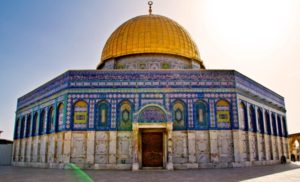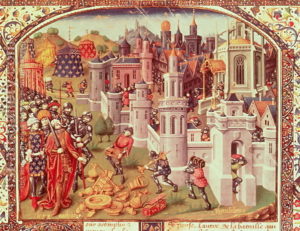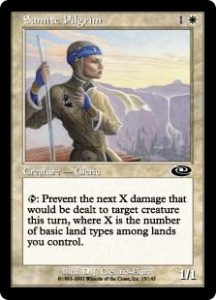In this week’s Uncharted Realms, Jace and the Zendikar merfolk Jori En travel to the Eye of Ugin to uncover the secrets of the hedron network and possibly re-confine the Eldrazi. After a long and perilous journey, the two adventurers find themselves without provisions, captured by zealots who maintain the Eldrazi as gods, following in Ulamog’s siphoning path across the lands of Zendikar as a holy pilgrimage. Jace continues on to the Eye of Ugin alone after their escape, and Jori returns to Sea Gate with a dire warning of Ulamog’s “pilgrimage” to the survivors at Gideon’s encampment.
Pilgrim’s Progress
The act of pilgrimage is as ancient as religious practice, and finds expression in diverse spiritual traditions around the world. In Hinduism, Christianity, Islam, Judaism, Olympian and Mayan paganism, and Mongol animism alike – all featured in various points in this column – certain sites were ascribed spiritual importance and became focal points of travel and worship for the faithful.
The rise of a sacred geography could be traced to a variety of reasons between faiths. Jerusalem, for example, became a holy site for all three major Abrahamic faiths (Islam, Judaism, and Christianity) throughout the ancient and medieval past. In Christianity, Jerusalem was the central setting for the Passion and Resurrection of Christ, the new covenant between God and humanity that defines the Biblical New Testament. In Islam, Jerusalem was the home and subject of prophecy (including the teachings of Jesus), and was the site of the Prophet Muhammad’s transcendent journey to Heaven known as Isra wal Mi’raj. Finally, Jerusalem was the ancient home of the Israelites, once and future setting for the Temple of Solomon whose third incarnation coincides with the arrival of the Messiah in Judaism.

The Dome of the Rock, at various points a Jewish temple, Christian church, and (as pictured) a Muslim mosque in the heart of Jerusalem.
So central were this and other sites to the religions of the medieval period that millions of the faithful endured the terrible hardship and uncertainty of travel to visit them in person. Driven by a desire to partake in the miraculous past of a holy site’s religious history, to bear witness to its place in prophecy, or to honor its legacy as a site important to the shared history of one’s people, religious pilgrims accounted for a tremendous amount of long-distance travel in an era in which one’s life was usually entirely spent and defined within twenty miles of their place of birth.
The act of pilgrimage is as ancient as religious practice, and finds expression in diverse spiritual traditions around the world for a variety of reasons.
Pilgrimage became vital to religious observance throughout various cultures and societies in the pre-modern era. When the future Chinggis Khan sheltered in the shadow of Mount Bhurkan Khaldun during his rise to power, the site was ascribed sacred importance by his descendants, and whenever a new Great Khan of his line was to be acclaimed all the armies of the Mongol nation were required to return from their posts halfway across the world to pay homage to his legacy. Pilgrimage to Mecca – the hajj – remains a fundamental tenet of Islam, in which the devout are asked to visit the holy city and partake in rites meant to recollect the site’s sacred history. The ability to go and see the sites of faith was vital to the maintenance of belief in the medieval era, inspiring people to undertake journeys no less perilous than Jace and Jori’s – and, potentially, just as destructive as Ulamog’s path across Zendikar.
Holy Sites, Unholy Slaughter
The history of Jerusalem hints as the darker impulses of pilgrimage throughout the medieval period and well into our present day. Pilgrims to holy sites were participants in a vast ritual observance which celebrated a shared past and laid claim to a specific vision of a site’s holy importance. Mutual respect for diverse traditions, however, was not a hugely common part of medieval religious belief.
In the year 1096 CE, then-Pope Urban II issued a sermon at Claremont, intended to address the plight of the Christian Eastern Orthodox Byzantine Empire, ostensible allies to the Church of Rome. Throughout the former territory of the Eastern Roman Empire, the rulers of Constantinople had lost sites of Christian history and populations of the faithful to the rising power of Islam. The Pope was prepared to offer the remission of sins to those who took up the Empire’s cause. Urban intended to issue a clarion call to the militant faithful, mobilizing an army of noble knights to support the Byzantines in the area of modern-day Turkey. What he inspired instead was a vast and unstoppable pilgrimage to Jerusalem.
Somewhere in his address, Pope Urban may have mentioned the city of Jerusalem, then under the control of the Egyptian Fatimid dynasty (who, again, esteemed the site as holy every bit as much as the Frankish Christians at Claremont). By simple association or passing mention, Jerusalem became inseparable from the Christian cause in Turkey and throughout the Byzantine domain. Instead of a modest chivalric force, thousands upon thousands of pilgrims from all walks of life heard his address by word of mouth and rumor of salvation. This campaign from 1096 CE to 1099 CE – which would later be called the First Crusade – was first referred to as a mere “armed pilgrimage”, undertaken by a legion of the faithful who wore crosses upon their clothes and swords at their side.

In the foreground of this image of Jerusalem’s capture, Crusaders pile up the loot seized from the city’s residents.
The end result of this pilgrimage was bloodshed that shocked much of the non-Christian medieval world. The pilgrims who arrived at Jerusalem had marched, ill-prepared and underprovisioned, for thousands of miles across hostile territory, cutting a swath through eastern Europe and Asia Minor. When they took the city, according to medieval chroniclers, they were determined to make it a Christian holy site – and none other. Driven by religious fanaticism, the intoxication of victory, and the memory of hardships endured, the Christian conquerors slaughtered the Muslim and Jewish inhabitants of the city, functionally depopulating Jerusalem. “Our men followed [the fleeing defenders], killing and slaying even to the Temple of Solomon” recalls the unknown author of the Gesta Francorum. “The slaughter was so great that our men waded in blood up to their ankles.”
Some pilgrims never reached the holy city at all. Frustrated by their total lack of planning, the Germanic crusade of a noble leader named Volkmar did not ever leave Europe. Instead of freeing Christian holy sites from ostensible oppression, these pilgrims took out their frustrations upon the local non-Christian population, beginning some of the first anti-Jewish pogroms in Hungary before finally being put down by royal forces.
“Our men followed [the fleeing defenders], killing and slaying even to the Temple of Solomon” recalls the unknown author of the Gesta Francorum. “The slaughter was so great that our men waded in blood up to their ankles.”
The pilgrimage was a source of both transcendent faith and incredible violence, with the Crusaders serving as the most notable example. The holy sites that inspired pilgrimage throughout the medieval period were ultimately also the physical homes of diverse citizens, some of whom did not share in the presumed sacred claim to the site’s importance. Where pilgrims were determined to purify the object of their journey, to make it their own and no other, and to enforce a site’s spiritual meaning upon its complex physical reality, they were capable of horrific violence in the name of misguided faith, just as much as the Pilgrims of Ulamog and their unholy god featured in the week’s Uncharted Realms.



